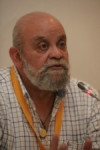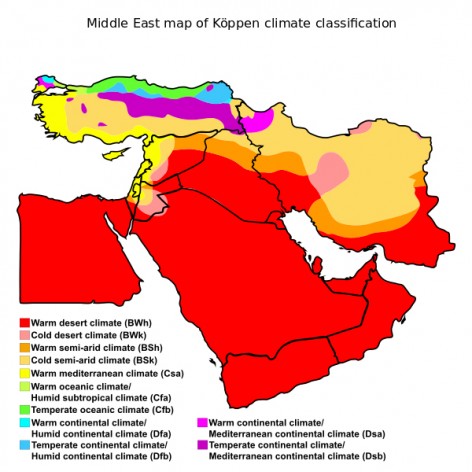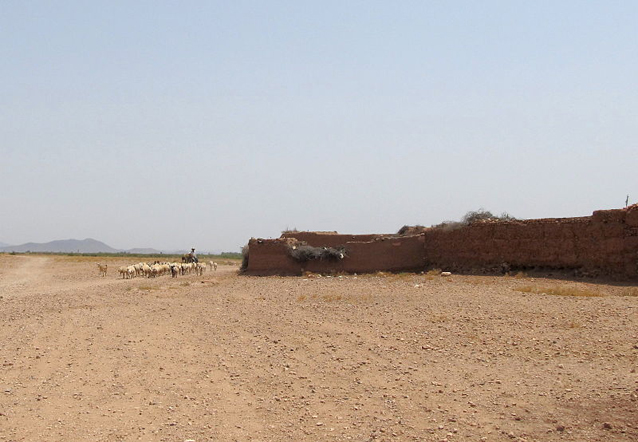Climate Change: Will the Middle East Become ‘Uninhabitable’? (I)
ENVIRONMENT, 25 Apr 2016
Baher Kamal – Inter Press Service-IPS
 This is the first of a two-part series of reports focusing on the impact of climate change on the Middle East & North of Africa region, ahead of the signing ceremony of the Paris climate agreement, on 22 April 2016 in New York.
This is the first of a two-part series of reports focusing on the impact of climate change on the Middle East & North of Africa region, ahead of the signing ceremony of the Paris climate agreement, on 22 April 2016 in New York.
Read Part II: Climate Change and the Middle East: No Water in the Kingdom of the Two Seas—Nor Elsewhere
18 Apr 2016 – This is not about any alarming header—it is the dramatic conclusion of several scientific studies about the on-going climate change impact on the Middle East region, particularly in the Gulf area. The examples are stark.
“Within this century, parts of the Persian Gulf region could be hit with unprecedented events of deadly heat as a result of climate change, according to a study of high-resolution climate models,” a recent Massachusetts Institute of Technology (MIT) research warned.

Middle East map of Köppen climate classification | 20 February 2016 | Derived from World Koppen Classification.svg.| Enhanced, modified, and vectorized by Ali Zifan.| Creative Commons Attribution-Share Alike 4.0 International license.| en.wikipedia
The research–titled “Persian Gulf could experience deadly heat”, reveals details of a business-as-usual scenario for greenhouse gas emissions, but also shows that curbing emissions could forestall these “deadly temperature extremes.”
The study, which was published in detail ahead of the Paris climate summit in the journal Nature Climate Change, was conducted by Elfatih Eltahir, a professor of civil and environmental engineering at MIT, and Jeremy Pal PhD ’01 at Loyola Marymount University.
The authors conclude that conditions in the Persian Gulf region, including its shallow water and intense sun, make it “a specific regional hotspot where climate change, in absence of significant mitigation, is likely to severely impact human habitability in the future.”
Running high-resolution versions of standard climate models, Eltahir and Pal found that many major cities in the region could exceed a tipping point for human survival, even in shaded and well-ventilated spaces. Eltahir says this threshold “has, as far as we know … never been reported for any location on Earth.”
MIT, which was founded in 1861 with the stated mission to advance knowledge and educate students in science, technology, and other areas of scholarship that will best serve the nation and the world in the 21st century, alerts that “detailed climate simulation shows a threshold of survivability could be crossed without mitigation measures.”
The research, which was supported by the Kuwait Foundation for the Advancement of Science, reveals that the tipping point involves a measurement called the “wet-bulb temperature” that combines temperature and humidity, reflecting conditions the human body could maintain without artificial cooling, the say.
That threshold for survival for more than six unprotected hours is 35 degrees Celsius, or about 95 degrees Fahrenheit, according to the recently published research.
The severe danger to human health and life occurs when such temperatures are sustained for several hours, Eltahir says — which the models show would occur several times in a 30-year period toward the end of the century under the business-as-usual scenario used as a benchmark by the Intergovernmental Panel on Climate Change.
An Even Hotter and Drier Middle East
For its part, the IPCC – Intergovernmental Panel on Climate Change latest assessment warns that the climate is predicted to become even hotter and drier in most of the Middle East and North of Africa (MENA) region.
Higher temperatures and reduced precipitation will increase the occurrence of droughts, an effect that is already materializing in the Maghreb,” says the World Bank while citing the IPCC assessment.

A scene in the high desert right outside of Marrakech, Morocco. A shepherd is guiding his sheep through the landscape in search of vegetation. | Credit: Johntarantino1 | Creative Commons Attribution-Share Alike 3.0 Unported license. | Wikimedia Commons
“It is further estimated that an additional 80–100 million people will be exposed by 2025 to water stress, which is likely to result in increased pressure on groundwater resources, which are currently being extracted in most areas beyond the aquifers’ recharge potential.”
In addition, agriculture yields, especially in rain fed areas, are expected to fluctuate more widely, ultimately falling to a significantly lower long-term average.
“In urban areas in North Africa, a temperature increase of 1-3 degrees could expose 6–25 million people to coastal flooding. In addition, heat waves, an increased “heat island effect,” water scarcity, decreasing water quality, worsening air quality, and ground ozone formation are likely to affect public health, and more generally lead to challenging living conditions.”
The World Bank report “Adaptation to Climate Change in the Middle East and North Africa Region” warns that the Middle East and North Africa region is particularly vulnerable to climate change.
“It is one of the world’s most water-scarce and dry regions; with a high dependency on climate-sensitive agriculture and a large share of its population and economic activity in flood-prone urban coastal zones.”
On the other hand, the report adds, societies of this region have been under pressure to adapt to water scarcity and heat for thousands of years, and have developed various technical solutions and institutional mechanisms to deal with these environmental constraints.
While global models predict sea levels rising from about 0.1 to 0.3 meters by the year 2050, and from about 0.1 to 0.9 meters by 2100, the World Bank says, for MENA, the social, economic, and ecological impacts are expected to be relatively higher compared to the rest of the world. Low-lying coastal areas in Tunisia, Qatar, Libya, United Arab Emirates, Kuwait, and specially Egypt are at particular risk.
Climate change also poses many challenges to the region’s cities, which represent hubs for economic, social, cultural and political activities. Rising sea level could affect 43 port cities—24 in the Middle East and 19 in North Africa, according to the World Bank study.
“In the case of Alexandria, Egypt, a 0.5 meter rise would leave more than 2 million people displaced, with 35 billion dollars in losses in land, property, and infrastructure, as well as incalculable losses of historic and cultural assets.”
____________________________________
Baher Kamal, Egyptian-born, Spanish national secular journalist. He is founder and publisher of Human Wrongs Watch. Kamal is a pro-peace, non-violence, human rights, harmonious coexistence defender among human beings and with Nature, with more than 43 years of professional experience. With these issues in sight, he covered practically all professional posts, from correspondent to chief editor of dailies and international news agencies.
DISCLAIMER: The statements, views and opinions expressed in pieces republished here are solely those of the authors and do not necessarily represent those of TMS. In accordance with title 17 U.S.C. section 107, this material is distributed without profit to those who have expressed a prior interest in receiving the included information for research and educational purposes. TMS has no affiliation whatsoever with the originator of this article nor is TMS endorsed or sponsored by the originator. “GO TO ORIGINAL” links are provided as a convenience to our readers and allow for verification of authenticity. However, as originating pages are often updated by their originating host sites, the versions posted may not match the versions our readers view when clicking the “GO TO ORIGINAL” links. This site contains copyrighted material the use of which has not always been specifically authorized by the copyright owner. We are making such material available in our efforts to advance understanding of environmental, political, human rights, economic, democracy, scientific, and social justice issues, etc. We believe this constitutes a ‘fair use’ of any such copyrighted material as provided for in section 107 of the US Copyright Law. In accordance with Title 17 U.S.C. Section 107, the material on this site is distributed without profit to those who have expressed a prior interest in receiving the included information for research and educational purposes. For more information go to: http://www.law.cornell.edu/uscode/17/107.shtml. If you wish to use copyrighted material from this site for purposes of your own that go beyond ‘fair use’, you must obtain permission from the copyright owner.